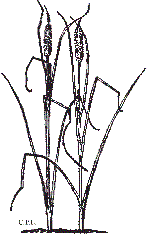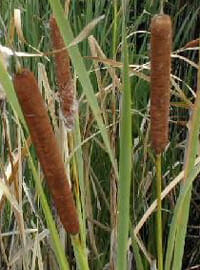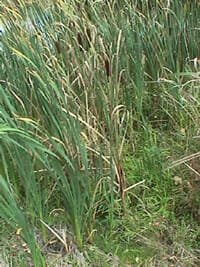Cat-tail Bulrush – Typhales Typhaceae Typha latifolia
 |
 |
 |
Identification & Description:
Common cattail has a nearly worldwide distribution. It grows in Africa, Australia, Central America, Great Britain, Eurasia, Japan, New Zealand and North America. It grows in arctic, temperate, subtropical and tropical regions in North America from central Alaska and northwest Canada to Newfoundland. They grow south through every territory, province and state to Mexico and Guatemala.
Habitat:
Cattails are an above water (emergent) large plant (macrophyte). They grow in shallow waters (less than 2.6 feet (80 cm) along the shores of the ponds, wet meadows, marshes and backwater areas of rivers and streams where seasonal flooding occurs. Cattails grow mostly in fresh water, but can also occur in slightly brackish marshes. They often form tall, dense stands that circle the edges of a pond or they can completely fill a pond. When stands of cattails die, the remaining organic material fills in a pond, making the pond more shallow. This condition makes the pond even more ideal as a cattail habitat. A “cattail meadow” can occur when this happens.
Plant Companions:
Cattail grows in the anoxic soil of marshes where there is little oxygen. Bulrushes (Scirpus), another emergent plant used in basketry, frequently grows in the same marshy area. Along water depth gradients, common cattail often grows upslope of bulrush or in open water but downslope of willow (Salix spp.), reed canarygrass (Phalaris arundinacea) and common reed (Phragmites australis). When both common cattail and narrow-leaved cattail grow in the same area, they are frequently separated by water depth, with common cattail found in shallow water and narrow-leaved cattail in deep water.
Distingushing Characteristics:
Common cattail is an aquatic or semiaquatic, erect, rhizomatous (creeping rootstock), perennial herb. Each vegetative shoot gives rise to twelve to sixteen erect, flat, linear, basal leaves, which are 0.3 to 0.6 inch (8-15 mm) wide and 3 to 10 feet (1-3 m) tall. A system of interconnected, gas-filled chambers run the length of the leaves and stems called lucunae transfer oxygen from the leaves to the roots of the cattail. They have a brown cylindrical fruit with a velvety surface.
Harvesting:
Gather cattail leaves at the end of the growing season once the leaves are full length, but before the tips begin to turn brown. Cut the leaf at the base with a sharp knife. Do not take all of any clump. Leave sufficient quantity to allow the clump to thrive. Once cut they must be dried before use to avoid excessive shrinkage. If you dry cattail in the shade they will keep their color. They will fade eventually with exposure to light. Try spreading the leaves on a screen door, tie and hang them in small bundles or string them to hang in a dry dark room with good ventilation. Covering the leaves with newspaper at night will keep the dew from accumulating on the leaves if they are dried outside. Gathering in August, might yield better quality with less spotting of the leaves but gathering in September provides the longest leaves. Choose the leaves that do not have the flower stalk so that the leaves separate easily. Wrap the dried bundles in a clean sheet to store them. Once dried, the leaves should be re-wetted and then wrapped in a moist towel to mellow before use.
Nutrition:
Just about all parts of the cattail are edible. It is considered one of the most versatile of wild foods. An acre of potatoes yields fewer carbohydrates than an acre of cattails, yet few people harvest these plants and the wetlands are quickly disappearing.
A knot of nutritious material can be found just above the rhizome and where the shoot connects to it. This is often referred to as the heart or root (not truly the root). This can be eaten raw or peeled and cooked to your tastes. This part of the cattail becomes less palatable after the plant sends up its flower spike.
The young shoots may be eaten in the winter and spring. Pull back the outer green leaves and grasping the white inner leaves, briskly pull it upward. The bottom twelve inches of the shoot can be eaten once the outer, fibrous layers have been removed. It is described as tasting like celery or cucumber.
The roots may be peeled while still wet and pounded till flour is sifted out. The root core is eaten raw, boiled to a starchy gruel (used to thicken soup), or roasted. Peel off the outer layer of leaves and sauté the core for three to five minutes in butter. Season with drops of soy sauce and a pinch of ginger. The tender cores of young plants are also added to green salad or in Russia, they may be cooked like asparagus.
Boil or steam in salted water and eat the partially developed female spike like corn on the cob. The staminate flowers, mixed with water, may be made into cakes and mush. The male spike may be harvested at mid-June and added to extend flour or for protein.
The ripe pollen can be added to flour for protein. Pollen pancakes are made by shaking pollen into a bowl and mixing equal amounts flour for batter, or it may be added to pancake mix (one-part cattail to two-parts mix). Mix the pollen with raw honey (five-parts cattail to one-part honey) for a high-energy food (refrigerate).